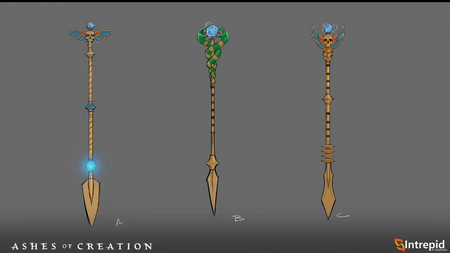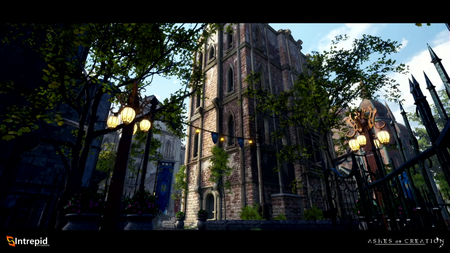Node progression
Nodes advance by collecting experience from the actions of players nearby. As players complete content inside of a Node’s Zone of Influence (the area around the node), they contribute that experience toward the Node’s development. The experience given to the Node may then be modified based on certain Events and Accomplishments. When a Node reaches the experience required, it undergoes the process of advancing to the next stage. There are a few exceptions where a Node cannot advance even though it has the required experience - most commonly, a Node can not advance if a Node is a Vassal of another Node and would advance to the same stage as its Parent Node.[1] – Margaret Krohn
A lakosok, és nem lakosok aktivitása (küldetések, gyűjtögetés, Raid-elés, stb.) a Node ZOI-ján belül annak a Node-nak a fejlesztését gyarapítja (fejlődés).[2] A Node-ok hét (7) fejlődési fázissal rendelkeznek, melyek mindegyikéhez hozzá van rendelve egy elérendő tapasztalatküszöb, a fejlesztéshez.[3]
| Node fázis.[2] | Alternatív név.[4] | Fejlesztéshez szükséges idő.[2] | Játékos lakások.[5] | |
|---|---|---|---|---|
| 0. | Vadon | - | ||
| 1. | Expedíció | Kereszteződés | Pár óra | - |
| 2. | Táborhely | Tábor | Órák | - |
| 3. | Falu | - | Pár nap | Kis házak |
| 4. | Kis város | - | Napok | Közepes házak |
| 5. | Város | - | Pár hét | Nagy házak |
| 6. | Metropolisz | Nagyváros | Hetek | Kastélyok |
The Development Area of a Node is where civilization will appear as the Node advances. As the Node Stage increases, different buildings, NPCs, and services will become available in the Development Area. The higher the Node Stage, the more complex and populated the Development Area becomes. Development Areas will also vary depending on the Node Type - Economic, Military, Scientific, or Divine; we’ll go into further details on each of those Node Types in future posts in this series.[1] – Margaret Krohn
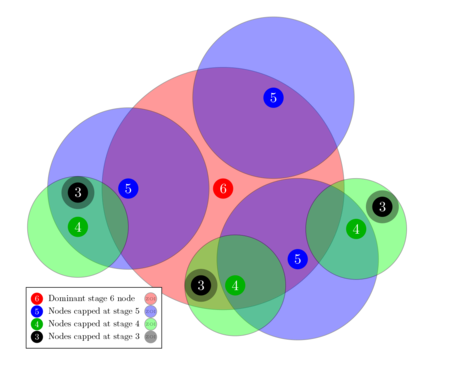
Beginning at Node Stage 3, when a Node advances, it enslaves nearby Nodes and makes them into its Vassals. Vassal Nodes are owned by a Parent Node and must always be at least one Node Stage below the Parent Node. This means that the Vassal Node cannot grow until the Parent Node advances in stage. Vassal Nodes give excess experience to their Parent Node, and are able to have their own Vassals, as long as they fit within the Parent Node’s Zone of Influence. They are subject to the government, alliances, wars, taxes, and trade of their Parent Node, and are able to receive federal aid from them. A Vassal Node cannot declare war on their Parent Node or any of its Vassals. Citizens of Vassals are bound by the diplomatic states of the Parent Node.[3] – Margaret Krohn
Egy Node fejlesztése elérhetővé teszi az egyedi tartalmát, amivel egyidejűleg egyre nagyobb körzetben akadályozza meg a szomszédos Node-ok fejlődését.[7]
- A Node-ok gyorsan érik el az első szintet. Ez elérhetővé teszi az NPC szolgáltatásokat, mint a bolt, vagy tárgyak eltárolása.[8]
- Minél fejlettebb egy Node, annál nagyobb a hozzá tartozó ZOI.[9]
- Kevésbé fejlett Node-ok (avagy vazallus Node-ok) amik fejlettebb Node ZOI-ján belül vannak, szerezhetnek további tapasztalatot, de nem fejlődhetnek a domináns Node szintjére.[6]
- A vazallus rendszer akkor lép életbe, ha egy Node eléri a 3.fázist (Falu), de a szomszédos, hármasnál kisebb Node-ok is megakadályozzák a közvetlen szomszédaik fejlődését.[10]
- A terület kiterjesztő algoritmus figyelembe veszi a legközelebbi tengerpartot, a szomszédos Node-okat és a környezetében lévő területek játékos-sűrűségét az elmúlt hetekben.[11]
- Azon okból, ahogy a kiterjeszkedést számító algoritmus kiszámolja egy növekedő Node ZOI-ját, előfordulhat, hogy két azonos szintű Node egymáshoz közel esik.[12]
The way that the algorithm expands the territories takes into account a few things: One it takes into account the coast like where's the closest coast. Two it takes into account the neighboring nodes so it can take over and essentially vassal state those nodes, but what's more important is essentially the initial population based on like how players choose their races. Because we have nine different races and four different starting points that branch out, each server's population density is going to dictate essentially the first few nodes that are that are highly populated and then that initial seed is what's going to determine the node structure as it moves inland into the into the world essentially; and based on the performance and successes of different sieges will determine which nodes that got locked out from the previous the initial advancements what nodes can now be available to advance further. So I really think that with so many variables that are present in the equation of how nodes advance and stay existing with the more variables you have, the higher likelihood there is for there to be a significant diversion in world progression.[11] – Steven Sharif
Normally the algorithm that's applied to the node territorial expansion will prevent significant nodes from being in close proximity to each other... There could be a perfect storm where all of the algorithmic progression of territory leads to having these nodes very close to each other because there's certain requirements that should that need to be available to satisfy node vassal takeovers; and it's possible that two nodes would never take each other over as vassals and end up close together and spanning their territories in opposite directions: The Tale of Two Cities thing.[12] – Steven Sharif
- A domináns Node nem kap tapasztalatot a vazallus Node-ok területén szerzet tapasztalatból, amíg azok el nem érik a számukra elérhető legnagyobb szintet.[6]
- A játékosok mozgatva(elteleportálva) lesznek, ha a fejlődés közben egy megjelenni készülő épület útjában vannak.[13]
- Egy Node lakosai gyarapíthatják egy eltérő Node fejlesztését.[14]
- A fejlődés konkrét tapasztalat követelménye (pl. hány szörnyet kell megölni) nem lesz nyilvánosan tudott, a rendszer kihasználását elkerülendő.[15]
Different people have different resources invested in nodes progressing and it would be a little "gamey" if you could know exactly what was necessary at that point because that would disincentivize people from participating.[15] – Steven Sharif
Vassal nodes
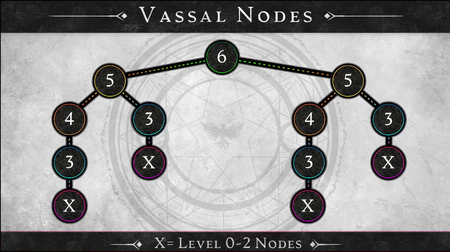
This vassal mode structure tells you what it looks like for a sovereign at a level six metropolis stage; and what it can control at a maximum vassal network is two level five nodes, of which a level five node can control one level four and one level three as direct vassals; and then the four can control a three; and every three can control a one or a two. Now if the three gets removed through siege, the one or the two is removed as well. So that's an important distinction between the three's vassals, which technically isn't really a vassal relationship because there's no citizenships possible. Those vassals don't exist between three and X, but they do exist between four and three, five and four, and six and five. And what this also allows is that because there are 85 nodes that are within the world, we have a buffer zone of about 20 nodes that lives in a max server state. So if you had maximum five metropolises form in a world, you will have a number about 20 nodes that can live alongside those metropolis networks; and when or if a metropolis falls, that extra cushion of nodes around the five metropolis structures allows for the map to be redistricted in a way that is unique. It doesn't mean that one of the fives is just going to pick up where the last six left off and form the same exact metropolis structure. From a territory perspective it has ancillary nodes to play with and expand towards that redistricts the map, so that if a metropolis falls there's a significant difference in the layout of the world and the layout of these almost nation-like territories.[16] – Steven Sharif
Village (stage 3) or higher nodes enslave nearby nodes, converting them into vassal nodes.[3][10]
- A Metropolis (színpad 6) can control up to two City (színpad 5) nodes. A City (színpad 5) can control one Town (színpad 4) and one Village (színpad 3) node. A Village (színpad 3) can control an Encampment (színpad 2) or an Expedition (színpad 1). If the Village (színpad 3) gets destroyed through a siege, its dependant Encampment (színpad 2) and Expedition (színpad 1) nodes are also destroyed.[16]
- There is a layer of intricacy between how the neighboring nodes advance and what potential parent structure they have in the vassalship tree.[17] – Steven Sharif
- Vassal nodes gain benefits from their regent node (also referred to as sovereign node or parent node) even if the node type of the parent is different to the vassal.[18][19]
- It is not a bad thing to be vasseled, it is a good thing to be vasseled. It brings many benefits from the Sovereign, which is the ultimate parent of that vassal network down to the vassal node itself; and it allows that vassal node to even live outside of its normal mechanics. You get to adopt some of the benefits that the node type of your sovereign is, even if your node type as a vassal node isn't the same.[19] – Steven Sharif
- Regent nodes collect taxes from their vassal nodes. These taxes cannot be taken by the mayor or other players.[21]
- Vassal nodes must remain at least one node stage below their parent node.[3]
- Neighboring/Adjacent nodes from Expedition (színpad 1) upward block the growth of their immediate neighbors. This was intended to be tested in Alpha-1.[22][10]
- Vassal nodes first apply any experience earned to their own deficit (see Node bomlás). It then applies excess experience earned to its parent node.[1]
- If the parent node advances, the vassal is once again able to advance.[3]
- Vassal nodes give excess experience to their parent node and may have their own vassals; so long as they fall within the parent node’s zone of influence.[21][3]
- If a node is capped and is both a vassal and has its own vassals, any experience earned from itself or its Vassals is first applied to its own deficit. Experience beyond that is then sent to its parent node.[1]
- When the vassal reaches its cap it overflows experience up to the parent; and so it can be very good early on for parents to get vassal nodes that are very productive- that have a lot of traffic.[21] – Steven Sharif
- Vassals are subject to the government, alliances, wars, taxes, and trade of their parent node, and are able to receive federal aid from them.[3]
- Vassal nodes cannot declare war on their parent node or any of their vassals.[3]
- Citizens of vassals are bound by the diplomatic states of the parent node.[3]
- If a Node is a Vassal Node and is capped from advancing further, it first applies any experience earned to its own deficit (see Node Atrophy section), and then applies excess experience earned to its Parent Node. If the Parent Node advances and the Vassal is able to grow, it becomes uncapped. If a Node is capped and is both a Vassal and has its own Vassals, any experience earned from itself or its Vassals is first applied to their own deficit. Any experience beyond that is then sent to its Parent Node.[1] – Margaret Krohn
Neighboring nodes
Adjacent nodes (Neighboring nodes) starting from Expedition (színpad 1) may block (lockout) the growth of their immediate neighbors.[22][10]
- Vassal nodes must remain at least one node stage below their parent node.[3]
- Encampment (színpad 2) and Expedition (színpad 1) nodes are technically not vassal nodes as they do not support citizenships. If their parent Village (színpad 3) node is destroyed by a node siege, these nodes are also destroyed.[16]
Node bomlás
Node-ok accumulate an experience deficit each day based on the node's level, called node atrophy. The deficit is subtracted from any experience earned that day. If any deficit remains, then this is subtracted from the node’s experience pool.[1]
- An atrophy system may be implemented, where accumulated atrophy points will progressively disable services within a node. The node may be destroyed if a significant points threshold is reached.[12]
- There are intrinsic problems with reducing a nodes level as opposed to removing the node and it may be possible I'm just gonna say now that we don't actually atrophy nodes to delevel but rather accrue atrophy points that must be replenished over time; and if not it begins to disable services and further compound the atrophy problem; at which point when it reaches a certain atrophy point then the node would just disappear.[12] – Steven Sharif
Relics

Each city has what's called a reliquary and the reliquary begins to spawn unique items for the citizens to take advantage of based on the performance, progression and achievements that those citizens have within the world. So if your citizens are part of downing a world boss or completing a dungeon in a record time or crafting a legendary item or whatever: all of these different types of progression paths for the cities could result in the production of a relic that exists within the reliquary.[24] – Steven Sharif
Relics are achievements for a node that unlock over time. They allow node citizens to craft certain legendary items and progress in certain legendary quest lines.[25][26]
- Relics are embodiments of certain types of achievements. You may have the scale of a dragon that's been defeated- the all-scale aspect of it- and from that every week a citizen might be able to derive one scale material component that can be used across a plethora of high-end types of crafting.[25] – Steven Sharif
- Relics automatically manifest in the node's reliquary when specific conditions are met by that node. For example, it may require a certain number of citizens to accomplish a particular achievement a number of times before the relic is granted to the node.[25][24]
- Let's say for example there is a dragon nearby and this dragon is a large raid boss; and the number of citizens that the node has that participates in that raid the first time- if you have 30 citizens present you may not achieve the relic. And it's not a matter of capturing it at that location taking back to the city. It'll automatically manifest within the reliquary if a number of citizens accomplish a particular achievement a number of times necessary to create the relic. So if you only have 30 citizens present at that raid boss you may need to do that raid boss four or five six times in order to unlock the achievement which grants the relic in the reliquary. So it's essentially incentivizing the citizens to participate in the world events around the node.[25] – Steven Sharif
- Relics can also be awarded for accomplishments that span many different progression paths, such the number of citizens achieving advanced stages of their artisan classes.[25]
- The other component of relics that's important to note is that it's not just adventuring relics, these are accomplishments that span a lot of the different progression paths. So you could have accomplishments get unlocked by how many number of citizens achieve the creation of a particular type of item. You may have now an alchemical genius that is a citizen of your node and as a result there is an alchemical relic that's been granted to your reliquary in a similar fashion to the dragon.[25] – Steven Sharif
- Relics stored in a node's reliquary grant passive and active benefits to node citizens and vassal states.[27]
- Limited access to the relics stored in a node's reliquary are granted to players after a node is destroyed by a node siege.[30][31][25][24][32][33][34] Benefits are also conferred to those who capture, steal, or sabotage relics held the reliquary.[27]
- Looting a relic from a node will create a shard of the relic, which can be used in recipes for certain crafted items and enchantments; or it can be consumed for a single-use buff that reflects the original relic's purpose.[35] These shards can be traded.[36]
- Relics include the four Ancient artifacts of Verra that were originally discovered by King Atrax in his pursuit of the power of The Essence.[37][38]
- These artifacts were in close alignment to The Essence on Verra due to their proximity to the ley lines of Essence spread across the world.[39]
- These artifacts were originally housed in the vault of Fallow's Hold, which is one of the great dungeons of Ashes of Creation, located near the capital city of the ancient Toren empire, Torall.[39]
- Constellations enable the acquisition of certain relics.[40]
- Certain relics can only be discovered through exploration.[41]
Ancient artifacts

This is not the Staff of the Ancients per-se, it's a staff... Here in the curvature and design of this staff you'll see that it has a very specific and unique looking type of mold so-to-speak. So there could be some relationship between these designs of the staves and/or weapons that you'll see, which are used to harness or focus the use of the Essence, or magic; and how perhaps those structures relate to the types of magic that those creatures are using.[43] – Steven Sharif
The Ancient artifacts of Verra were originally discovered by King Atrax in his pursuit of the power of The Essence.[37][38] These artifacts were in close alignment to The Essence on Verra due to their proximity to the ley lines of Essence spread across the world.[39] These artifacts were originally housed in the vault of Fallow's Hold, which is one of the great dungeons of Ashes of Creation, located near the capital city of the ancient Toren empire, Torall.[39] They are now considered relics that can be acquired by nodes and housed in their reliquary.[37][38]
- The Golden Chalice was believed to bring everlasting life but was actually allowing the corruption of manipulating The Essence to enter the soul through the physical representation of drinking something.[37]
- The Crown represented a direct link The Ancients had into the thought process of King Atrax that the Ancients were able to manipulate.[37]
- The Sword brought unusual power through manipulation of the evil side of the Essence, which is how Atrax maintained his dominance over his people: through physical might, essentially striking down any foe that opposed him among his administration.[37]
- The Staff enabled Atrax to project his magic across great distances, which enabled him to extend his power and manipulation throughout the lands of Verra and allowed him to maintain vigilance over his realm.[37]
- The Toren Godspike is an artifact that could initiate a fissure that can siphon out Essence that lies within Verra. This artifact can be used as part of certain war declarations.[42][44]
Racial influences
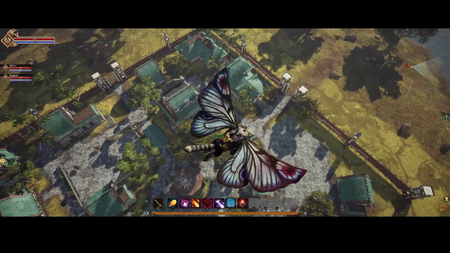
We have essentially sets that exist across all races; and each race that dons those armor sets is going to have their own racial influence on the presentation of those particular sets. So that's something that's unique in how each of the races get diversified. Additionally, the more that one particular race contributes to a node's development, it's going to manifest in that particular node's architectural influences. You're going to see the architectures of those races become manifest within the nodes as well: That's another way that we diversify each race and we present each race's culture in the game as through those architectures, through those props that exist, through the tailoring of the armor sets that the NPC might wear, to the different factions that exist. Factions will have their own affiliation with different races as well. Each race will also have some different nomenclature when it comes to the lore, or comes to locations in the world. They're going to have their own language influences as well: The way they speak is something that's going to be distinct between races; when you have dialogue trees with particular NPCs. So all of those things really go into setting an immersive world where the cultures have their own identity.[46] – Steven Sharif
Cultural influences manifest in many ways, from node and gear aesthetics to NPC languages and lore.[46][47][1]
- Gear appearance of certain armor sets is influenced by the player's race.[46]
- Node layout and style is influenced by the race that contributes the most to that node.[46]
- There is an attrition and that attrition on experience and influence is heightened based on the performance of the race in the world. So if all these nodes are Orc nodes then their attrition rate is very high to compete with the cultural establishment of new nodes because they have more influence in the world and a popular opinion is against them in their outlying regions that they do not have influence in.[48] – Steven Sharif
NPC racial interaction
- NPCs will react differently to different character races.[49]
- Languages will be distinct between NPC races and in the lore.[46]
- Certain quest givers and NPCs may only be present at nodes with certain cultural influences.[50]
- Depending on the cultural influence of the node activates certain types of quest lines and/or sponsors. Some of those are shared, some of those are general. Some of those relate to a progression path that is a first time user experience. Those will be constant across all culture types. Some of them, however, are predicates that spawn when certain story arcs and/or events, or commissions or buy orders become present within the node; and those might change based on the cultural influence of the node. So there is a separation between those populations.[50] – Steven Sharif
Node layout and style
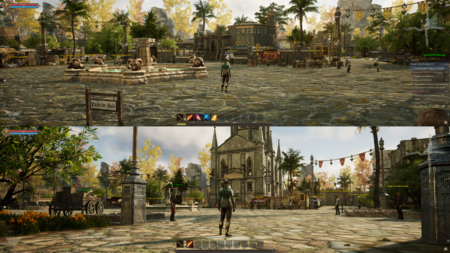
The layout and architecture within a Node’s development area are determined by influential race. For example, a stage 3 Node with the majority of player contribution being Py'rai would have a Py'rai village with Py'rai architecture. Most NPCs would be Py'rai elves, and offer questlines within the Py'rai narrative.[3] – Margaret Krohn
Each player’s contributed experience is flagged with their character race and other identifiers. When a Node advances, the race with the highest experience contribution determines the Node’s style and culture. This style and culture change can happen at every Node Stage. For example, if a Node advances to Level 2 - Encampment Stage and 51% of all experience was earned by Ren’Kai players, the Node will be a Level 2 Ren’Kai Node. If that same Node advances to a Level 3 - Village Stage Node, but the Py'Rai contributed 62% of all the experience earned, then the Node will be a Level 3 Py'Rai Node.[1] – Margaret Krohn
Node layout and style is determined by several factors:[51][52]
- The way that the node system is built is that they can exist across a spread of 18 biomes, but at the same time have to represent the cultural influence of these cultures that are intrinsically a part of a specific biome.[53] – Steven Sharif
- Environment (biome) and location of the node.[53][51][52]
- Nodes will adjust the local topography to fit the aesthetic and mechanical requirements of the node.[54]
- Currently the way that the platform system is set up, is it's capable of adjusting the topography of the node's footprint, regardless of the surrounding terrain. So the reason for that is we want to have flexibility in the presentation of the node's layout and how it is essentially both from an aesthetic standpoint as well as a mechanical standpoint with node sieges- how it's constructed and that construction should have the ability to take on a variance of different types of topography. So it shouldn't be dependent on the surrounding area. Now that's not to say that the surrounding area isn't going to have some influence over. So for example... we're experimenting a little bit with the platform tech and putting up a node up against the side of a mountain or on the edge of a cliff or something that has a beautiful vista. Those are things that we're going to test out obviously as we continue to work on the node tool and how that platform system works, but the idea is to have the node independent of the surrounding terrain.[54] – Steven Sharif
- Some parts are determined by the area it's in. Some parts are determined by the type it is. Some parts are determined by the race it is; and then the rest of it is determined by the mayor.[52] – Jeffrey Bard
- Race that contributed the highest percentage to the node's advancement will alter the racial appearance of its buildings, NPCs, and props.[46][55][51][1][52][56][57]
- All nodes, whether they're associated with a castle or associated with normal node structure, has cultural influences that replicate over to the buildings that are produced and the NPCs that are present.[59] – Steven Sharif
- The rest is determined by the node's mayor.[52]
- It should be possible for a node to complete several building projects within a mayor's one month term in office.[60]
- Q: How long would you say it will take players on average to fill/build up a node completely from wilderness to metropolis?
- A: It's one thing to get a node to a certain level: it's another thing to develop the node; and I can't really give you an on-average expectation, because there's a lot of variables at play. There's how many citizens does the node have attracted to it; what's the type of traffic that the node is attracting to it based on things like its tax rates, or the specialization that it chose to spec into, based on the building types it's chosen to build. All of those things are variables that can affect the quote-unquote "average build-out time" of a particular node. So it's difficult to give you an average when there's so many variables along those lines. But the idea is that if there is a particular project that players are interested in in developing based on the node stage, that they would have the ability to complete several of those projects as within a single term of a mayor; and a term of a mayor is one month.[60] – Steven Sharif
NPC racial interaction
- NPCs will react differently to different character races.[49]
- Languages will be distinct between NPC races and in the lore.[46]
- Certain quest givers and NPCs may only be present at nodes with certain cultural influences.[50]
- Depending on the cultural influence of the node activates certain types of quest lines and/or sponsors. Some of those are shared, some of those are general. Some of those relate to a progression path that is a first time user experience. Those will be constant across all culture types. Some of them, however, are predicates that spawn when certain story arcs and/or events, or commissions or buy orders become present within the node; and those might change based on the cultural influence of the node. So there is a separation between those populations.[50] – Steven Sharif
Unique node buildings
Each node type has a unique service building associated with it that can be activated at Village (színpad 3) of node advancement.[62] The unique building plays a central role in the progress of civilization for a server.[63]
Racial quests
Küldetések may be based on a character's race.[49]
Different quests may relate to who the primary cultural contributor is to a node. This won't lock out content, but will add flavor to the quests.[49]
There might even be different directories of the quest that exist for specific races, and even though you're sharing a quest to kill a boss, if you're human and I'm an elf, I will have a different arc potentially that leads in a different direction than you, even though we took the same quest; and this can relate to who the primary cultural contributor is to a node unlocking different arcs for cultures that share the primary culture of a node - not that locks out content but it gives a flavor in a different direction so that not everything is so cookie cutter.[49] – Steven Sharif
Race matters because narratives have paths that also are influenced based on the primary contributing culture to the node... If you're a Niküa and you have you're in a Niküa node that's predominantly Niküa, you're going to have certain services and/or abilities as a member of the Niküa race that other races may not have access to... They may have alternative quest lines, but they won't have specific ones. Now those specific Niküa quests will then relate to the meta-narrative that's present in the world and they'll start to direct some of that meta-narrative; and that'll be beneficial for your kind because it will unlock certain content for your race that other races haven't unlocked yet. So there is an incentive there to see progression along that line now in order to curb the progress of a dominant race.[48] – Steven Sharif
Küldetések that are race specific, title specific, or guild specific will likely be less than 10% of the total number of quests. 90% of quests should be able to be shared by everybody.[64]
Trophy park
Trophy park is an area within Town, City or Metropolis nodes that has available spots for trophies. These trophies show the character names of players who are the first to complete world bosses and dungeon bosses that were spawned as the result of the development of that particular node.[65]
- Server announcements and achievements are designed to encourage groups to experience new content.[65]
Node government
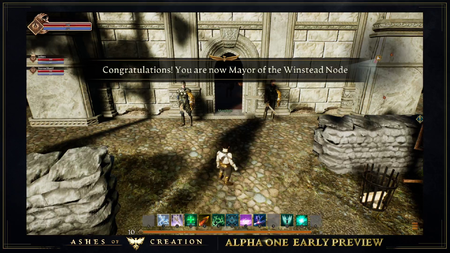
There are a number of different seats that can exist within a node, and carry different responsibilities.[67] – Steven Sharif
Positions within a node's government are attained through seasonal titles that grant special powers and benefits within the node.[68][67][69][70]
There are other node-based positions. Most of them relate to social organizational structures like the temple and the social organization building that the node might construct. Those are ladder systems of achievement that players can work through on a seasonal basis to achieve the highest level of that for the particular node; and by doing so they will then have titles bestowed upon them, which grants certain types of powers and benefits.[68] – Steven Sharif
- Mayors.[71]
- Priests, bishops, or acolytes of temples.[68][72][69]
- Social organization positions.[68]
- Patron guild leaders.[69]
- Chief bounty hunter.[69]
Leadership powers
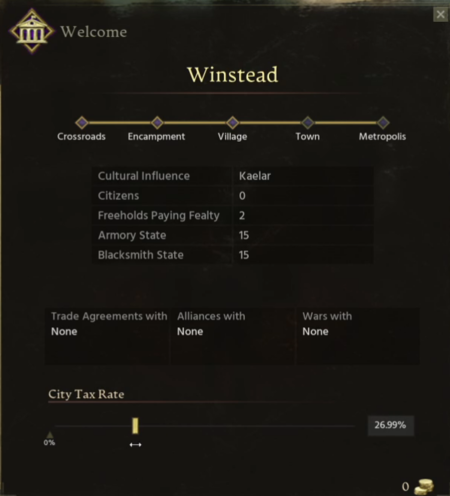
The government has a lot of say in the direction of the node's development. Directing assets, building projects, tax allocation, defensive ability etc. Players have the ability to not only create these cities, but they have the right of self-governance.[70]
Mayoral leadership powers are granted to mayors via the use of mandates.[73][71]
- Initiate buy orders using gold from the node treasury.[74][75][76][77]
- Initiate mayoral commissions to aid node development.[74][78][76][73][79][70]
- Adjust node taxes.[74][73][80] This includes setting tax rates that apply to tavern games.[81][82]
- Tax money may only be used to fund node development.[83]
- Initiate service building construction and expansions.[74][73]
- Improving node defensive structures, such as stronger walls and gates, traps, and siege equipment.[79][28][84][85][70]
- Hiring mercenary NPCs to defend the node during sieges.[86][70]
- Set a message-of-the-day for the node.[87]
- Proposing node policies that are voted on by citizens.[88][89][79]
- Mayors won't have formal systems to carry out surveys/polls of node citizens, but they will be able to utilize node citizen chat or message-of-the-day services.[87]
- Mayors may have special color names in node chat channels.[87]
- Entering into trade agreements with other nodes.[74][88][90]
- Mayors cannot denote players as enemies of the state.[92] Previously this was a potential option.[90][93]
- Mayors are notified when their node is named on a siege declaration scroll.[94]
- Mayors and lords of castles have spells they can use on the battlefield with high effect and long cooldowns for their teams.[95]
- Mayors gain new powers and responsibilities as their node advances.[3]
- Some leadership powers are specific to node type, biome, or dominant race, others are universal.[97]
- There definitely are differences... Some of the things that mayors can do are more universal, but then some systems have very specific if your node has a certain dominant race, or your node is a certain type, or it's in a certain biome. So there's even differences between where it is too.[97] – Chris Justo
- If a mayor does not make certain decisions within a set period of time then the system will make a decision for them.[99][100]
- Q: The idea behind all these nodes are awesome, but I wonder how it will actually play out in the live version. The problem is having player run or the problem with having player run towns is that people come and go in video games. So, will towns die out etc?
- A: We incorporate as part of those designs certain fail-safes, certain protections, certain automated progression that takes over when some of those decisions are lacking or are not made; and those decisions can be defaulted. Now, of course, that would have a deleterious effect on the direction that a particular node might want to go, because they're going to be doing default behaviors, or default actions, as opposed to something that might be in line with the strategic objective of that particular node, or the specialization that the node has previously been attempting to do. But that is why we have a regularly recurring election period where players can take the reins of power and can elect someone else to come in and participate and and re-right the ship, so to speak. So it is absolutely a component of having player-driven mechanics that there is an opportunity for things to be less than ideal, or less than strategic when certain bad-faith actors or people leave, but there are safeguards in place.[99] – Steven Sharif
Node taxes
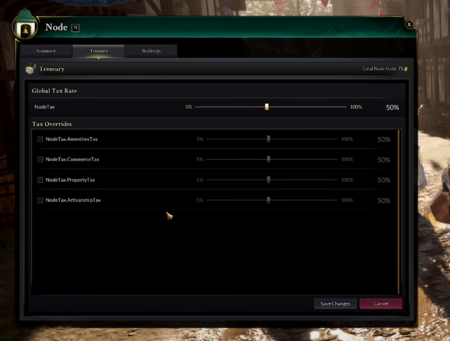
As the node levels up, you're gonna get access to deeper controls on the taxes, so that you as a Mayor can incentivize players to come to your node to do certain things. If you're a node that loves smithing, you're probably going to want to lower your taxes on artisanship to incentivize players to be here. But then you might want to drive up taxes on other avenues that players aren't necessarily coming to your node for, but are using out of convenience.[105] – Chris Justo
Mayors are able to set a generalized node tax rate as well as overrides for different activities within their node. Mayors gain additional taxation controls as their node advances.[105][80]
- Amenities tax override.[105]
- Artisanship tax override.[105]
- Commerce tax override.[105]
- This may include taxes that apply to tavern games.[81][82]
- Property tax override.[105]
- Freehold property taxes scale according to the number of freehold building permits issued for that freehold.[106][107][83]
- Citizenship dues and property taxes scale based on the stage of the node when a player became a citizen.[74][108][109][110][111]
- The goal is to exert financial pressure on node populations by making taxes increasingly expensive as nodes advance, rather than putting in place hard population caps.[109][110]
- Node tax rates will be visible on the world map by hovering over a node location.[112]
- Tax revenue only goes toward funding node development. This cannot be withdrawn by the mayor or any other player.[21][83]
Regent nodes take a cut of taxes from various activities that occur within their vassal node structure.[21][113]
- This tax doesn't necessarily impact the individual citizen, because citizen's tax levels are determined by their node, but the node's finances are affected by the taxation levied by its parent nodes.[113]
Node wars
Node governments may declare war on another node and rally citizens to the cause.[79][90]
- This mutually flags the citizens of the warring nodes, including their allies, as combatants.[114]
- Társadalmi szervezetek quests will either be cooperative or adversarial based on the war status of their parent nodes.[114]
- Vassal nodes cannot declare a node war on their parent node or any of their vassals.[3]
- Node wars can be declared at any time, but the objectives will only spawn during server prime-time.[115]
- Players can kill each other at any time during the war (not only during server prime-time).[115]
- Node wars affect reputation between the nodes.[74][88]
- We have conditions that you can set between nodes with regards to either nodes being friendly with each other and acting trade alliances, or they can declare war on nodes similar to how guild wars may function in different games, where those citizens become hostile to each other based on the player government that's elected in the particular node. So those systems all cater to allowing a conflict that's meaningful and that also provides a non-imbalanced relationship between stronger guilds and not as strong guilds.[111] – Steven Sharif
Alliances
Az Ashes of Creation tartalmazhat a szövetségek köré épülő tartalmat.[116]
- Fejlődési útvonalak a szövetségeken belül.[116]
- Céhek szolgáltatásokon osztoznak a többi szövetséges céhvel.[116]
- Szövetségek ki- bekapcsolhatják a viszonyukat Node-okkal.[116]
Tartalom ami a szövetségek köré épül és haladás a szövetség fejlődésében; és az azon belüli céhek lehetősége hogy egymás közt közös szolgáltatásokon osztozzanak. Szerintem ezen felül a szövetségeknek megengedni ki- és bekapcsoljanak bizonyos kapcsolatokat konkrét Node-okkal előnyös. Ez egy érdekes interakciót fog eredményezni olyan játékosoknak akik egy Node - Szövetség viszonyból valamelyiknek a tagjai. Szóval szerintem egyértelműen rendszerek építése arról szól hogy még több lehetőséget adjunk a játékosoknak viszonyrendszerek kiépítésére, és minél több ilyen réteg van amin keresztül a játékosok csoportosulhatnak, annál stabilabbak ezek a viszonyrendszerek.[116] – Steven Sharif
Stock exchanges (also called Stock markets and Share markets) enable players to buy and sell shares in Node-ok, Céhek and Társadalmi szervezetek.[117][118][119]
- Stock exchanges were a Kickstarter stretch goal unlocked for reaching the $3 million dollar mark.[119]
- This is a planned feature for the launch of Ashes of Creation.[117]
- The value of stocks is influenced by world events and the performance of nodes, Társadalmi szervezetek or guilds.[120]
- Hard metrics, such as quest lines, nearby resources, citizen progression, and purchases of local real estate, will determine the value of purchasable shares.[119]
- There is no regulatory commission to restrict the purchase and sale of stocks.[120]
Továbbiak
Hivatkozások
- ↑ 1.00 1.01 1.02 1.03 1.04 1.05 1.06 1.07 1.08 1.09 1.10 Blog - Know Your Nodes - Advance and Destroy.
- ↑ 2.0 2.1 2.2 A reactive world - Nodes.
- ↑ 3.00 3.01 3.02 3.03 3.04 3.05 3.06 3.07 3.08 3.09 3.10 3.11 3.12 Blog - Know Your Nodes - The Basics.
- ↑ 4.0 4.1 Élő adás, 2018-12-12 (14:48).
- ↑ Interjú, 2020-07-20 (3:45).
- ↑ 6.0 6.1 6.2 Élő adás, 2017-10-16 (50:20).
- ↑ Video, 2017-04-20 (0:02).
- ↑
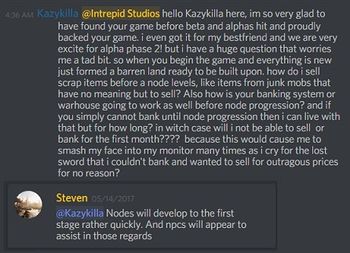
- ↑ Node series part II – the Metropolis.
- ↑ 10.0 10.1 10.2 10.3

- ↑ 11.0 11.1 Interjú, 2020-07-18 (10:04).
- ↑ 12.0 12.1 12.2 12.3 12.4 Interjú, 2020-07-08 (1:00:15).
- ↑ Élő adás, 2017-11-17 (55:27).
- ↑
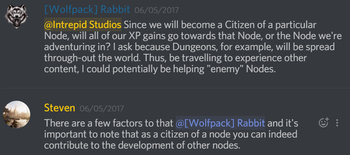
- ↑ 15.0 15.1 Élő adás, 2017-05-26 (28:16).
- ↑ 16.0 16.1 16.2 16.3 Élő adás, 2022-08-26 (1:07:34).
- ↑

- ↑ Élő adás, 2023-08-31 (52:56).
- ↑ 19.0 19.1 Élő adás, 2022-08-26 (1:04:35).
- ↑

- ↑ 21.0 21.1 21.2 21.3 21.4 Élő adás, 2022-08-26 (1:10:16).
- ↑ 22.0 22.1

- ↑

- ↑ 24.0 24.1 24.2 Interjú, 2020-07-18 (56:11).
- ↑ 25.0 25.1 25.2 25.3 25.4 25.5 25.6 Podcast, 2021-09-29 (10:49).
- ↑ Élő adás, 2018-02-09 (29:26).
- ↑ 27.0 27.1 Élő adás, 2022-04-29 (27:00).
- ↑ 28.0 28.1 Élő adás, 2020-07-25 (1:22:40).
- ↑ Élő adás, 2020-06-26 (1:33:10).
- ↑ Élő adás, 2022-10-14 (52:31).
- ↑ Podcast, 2021-09-29 (14:21).
- ↑ Interjú, 2020-07-08 (57:46).
- ↑ Élő adás, 2020-04-30 (1:14:44).
- ↑

- ↑

- ↑

- ↑ 37.0 37.1 37.2 37.3 37.4 37.5 37.6 Élő adás, 2020-11-08 (15:01).
- ↑ 38.0 38.1 38.2 Élő adás, 2020-11-08 (00:49).
- ↑ 39.0 39.1 39.2 39.3 Élő adás, 2020-11-08 (07:58).
- ↑ Video, 2022-12-02 (11:11).
- ↑ Élő adás, 2023-02-24 (6:51).
- ↑ 42.0 42.1 Élő adás, 2024-03-29 (2:21:10).
- ↑ 43.0 43.1 Élő adás, 2020-11-30 (52:56).
- ↑

- ↑ Élő adás, 2020-06-26 (45:32).
- ↑ 46.0 46.1 46.2 46.3 46.4 46.5 46.6 Élő adás, 2022-03-31 (4:57).
- ↑ 47.0 47.1 Interjú, 2021-02-07 (33:00).
- ↑ 48.0 48.1 48.2 Interjú, 2018-05-11 (1:00:19).
- ↑ 49.0 49.1 49.2 49.3 49.4 49.5 49.6 Podcast, 2018-04-23 (29:56).
- ↑ 50.0 50.1 50.2 50.3 Interjú, 2023-07-09 (1:35:28).
- ↑ 51.0 51.1 51.2 Élő adás, 2020-10-30 (39:17).
- ↑ 52.0 52.1 52.2 52.3 52.4 52.5 Élő adás, 2018-09-27 (53:06).
- ↑ 53.0 53.1 Élő adás, 2022-02-25 (41:00).
- ↑ 54.0 54.1 Élő adás, 2021-02-26 (1:12:18).
- ↑ Podcast, 2021-04-11 (29:47).
- ↑ Interjú, 2018-05-11 (54:34).
- ↑ Élő adás, 2017-05-26 (21:23).
- ↑ Podcast, 2021-04-11 (23:36).
- ↑ 59.0 59.1 Interjú, 2018-05-11 (47:27).
- ↑ 60.0 60.1 Élő adás, 2022-07-29 (1:13:09).
- ↑ Élő adás, 2018-09-01 (36:28).
- ↑ Élő adás, 2023-08-31 (56:18).
- ↑ Know Your Nodes: Economic Node Type.
- ↑ Élő adás, 2019-07-26 (1:13:23).
- ↑ 65.0 65.1 Podcast, 2018-08-04 (1:35:58).
- ↑ Élő adás, 2020-03-28 (1:02:46).
- ↑ 67.0 67.1
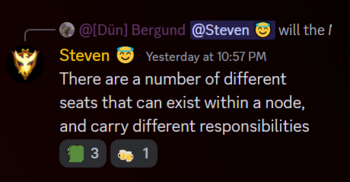
- ↑ 68.0 68.1 68.2 68.3 Élő adás, 2023-09-29 (1:07:01).
- ↑ 69.0 69.1 69.2 69.3 Élő adás, 2019-07-26 (1:20:48).
- ↑ 70.0 70.1 70.2 70.3 70.4 70.5 70.6 70.7 MMOGames interview, January 2017
- ↑ 71.0 71.1 Élő adás, 2017-11-17 (9:49).
- ↑ 72.0 72.1 Élő adás, 2020-07-25 (1:52:45).
- ↑ 73.0 73.1 73.2 73.3 Élő adás, 2023-08-31 (31:44).
- ↑ 74.0 74.1 74.2 74.3 74.4 74.5 74.6 Blog: Development Update with Village Node.
- ↑ Élő adás, 2023-08-31 (59:43).
- ↑ 76.0 76.1 Interjú, 2020-07-08 (1:04:05).
- ↑ 77.0 77.1 Élő adás, 2017-06-30 (53:57).
- ↑ Élő adás, 2023-08-31 (39:17).
- ↑ 79.0 79.1 79.2 79.3 79.4 Élő adás, 2022-04-29 (27:42).
- ↑ 80.0 80.1 Élő adás, 2020-03-28 (1:03:38).
- ↑ 81.0 81.1

- ↑ 82.0 82.1

- ↑ 83.0 83.1 83.2

- ↑ Élő adás, 2018-01-18 (37:05).
- ↑

- ↑ Élő adás, 2020-06-26 (59:11).
- ↑ 87.0 87.1 87.2 Élő adás, 2023-08-31 (35:23).
- ↑ 88.0 88.1 88.2 Élő adás, 2023-08-31 (44:21).
- ↑ Élő adás, 2022-08-26 (1:12:40).
- ↑ 90.0 90.1 90.2 90.3 City hall.
- ↑ Élő adás, 2023-08-31 (29:04).
- ↑ Élő adás, 2023-08-31 (30:41).
- ↑
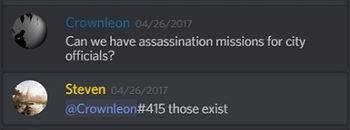
- ↑ Élő adás, 2021-12-23 (1:30:34).
- ↑ 95.0 95.1

- ↑ Élő adás, 2023-08-31 (41:15).
- ↑ 97.0 97.1 Élő adás, 2023-08-31 (28:30).
- ↑
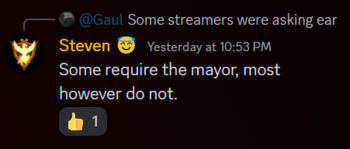
- ↑ 99.0 99.1 Video, 2023-09-29 (1:52).
- ↑ Élő adás, 2023-08-31 (29:33).
- ↑

- ↑ Élő adás, 2017-05-19 (36:05).
- ↑ Élő adás, 2017-05-19 (36:09).
- ↑
- ↑ 105.0 105.1 105.2 105.3 105.4 105.5 105.6 105.7 Video, 2023-08-31 (28:04).
- ↑ Interjú, 2023-07-09 (54:46).
- ↑ Élő adás, 2023-06-30 (1:45:22).
- ↑ Élő adás, 2023-08-31 (15:51).
- ↑ 109.0 109.1 Interjú, 2023-07-09 (38:14).
- ↑ 110.0 110.1 Interjú, 2020-03-27 (0:30).
- ↑ 111.0 111.1 Video, 2018-04-05 (41:48).
- ↑ Élő adás, 2023-09-29 (1:11:22).
- ↑ 113.0 113.1 Interjú, 2018-05-11 (57:02).
- ↑ 114.0 114.1 Interjú, 2020-07-19 (24:34).
- ↑ 115.0 115.1

- ↑ 116.0 116.1 116.2 116.3 116.4 Podcast, 2018-05-11 (21:07).
- ↑ 117.0 117.1

- ↑ 118.0 118.1 Élő adás, 2017-05-17 (11:27).
- ↑ 119.0 119.1 119.2

- ↑ 120.0 120.1 Interjú, 2018-10-20 (5:51).
